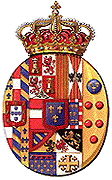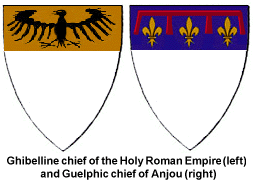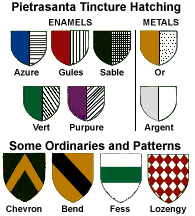...Best of Sicily presents... Best of Sicily Magazine. ... Dedicated to Sicilian art, culture, history, people, places and all things Sicilian. |
by Luigi Mendola | ||
Magazine Index Best of Sicily Arts & Culture Fashion Food & Wine History & Society About Us Travel Faqs Contact Map of Sicily |
The first part in this series was an introduction to Sicilian heraldry and the functions of heralds. The essential principles of heraldry are not difficult to understand or learn. In addition to the basic tinctures (colours) there are various geometric designs (ordinaries such as the chevron, chief, fess and bend), smaller designs known as subordinaries, and numerous charges (symbols). Over time, however, heraldry became somewhat more complex --a development which owed much to the introduction of printing in Europe (it had already been invented in China) and the artistic influences of the Renaissance. In view of such simplicity, how did we arrive at complex designs such as the coat of arms of the House of Bourbon-Two Sicilies shown here? Quartering, Differencing, Augmentations With this evolved the practices of "differencing" for
cadency; in other words using symbols to indicate An augmentation was a charge or ordinary added to a coat of arms by royal authority to indicate an armiger's loyalty or military merit. A distinctively Italian development in this direction was the chief of allegiance: three golden fleurs de lis between a red label on a blue field for the Guelphs and a black eagle displayed on a gold field for the Ghibellines. These were based on the arms of the Angevins (the gold fleurs de lis on a blue field) and the Hohenstaufens (the crowned, uncrowned or double-headed black eagle displayed upon a gold field). The chief of allegience was virtually unknown in Sicily, a key region contested by both factions, but these chiefs (a chief is an "ordinary" that occupies the upper horizontal third of the shield) made their way into the coats of arms of many families of northern and central Italy. Symbolism Many Italian coats of arms are more "pictorial" than those of other regions, a trend which seems to have begun during the middle of the thirteenth century and continued into the Renaissance and beyond, though as an artistic movement the Renaissance per se had far less influence in Sicily than it did in Italy's northern cities. Graphic Representation Still later, during the sixteenth century, the first armories were published in book form, transcribed from the blazons recorded in scrolls. In England serious attempts were made to control heraldry (eventually heralds conducted "visitations" of remote regions to ensure that armorial abuses were not being perpetrated by usurpers claiming to be armigerous), but in Italy this did not occur. Indeed, while most courts had heraldic officers there were also "independent" heralds in Italy. These "heralds errant" made their services available to any nobleman or other armiger (or aspiring armiger) willing to pay them. Seals for wax impressions became popular among important armigers, such as those who had to sign feudal documents. By 1700 these were increasingly popular in the form of heavy silver or gold rings which by their nature were more portable than heavy seals attached to handles, and offered the added advantage of serving as ready identification as well. Surprisingly few of these signet rings have been preserved; those in the greatest families rarely date from before 1800. Yet even many of those engraved in the nineteenth or twentieth centuries reflect a touch of traditional artistry. Coats of arms were also carved into stone, especially above the entry portals of aristocrats' homes, or in effigies of stone sarcophogi. Armorial Achievements and Crest Coronets Having mentioned the general absence of indications of cadency in Italian
escutcheons, it is important to describe how an armiger's position in his
family is depicted in his full achievement. In Italy a system of coronets
(crowns) is employed to this end. A different coronet exists for each rank:
noble prince (principe), duke (duca), marquess (marchese),
count (conte), viscount (visconte), baron (barone),
patrician (patrizio), untitled nobleman (nobile), hereditary
knight (cavaliere ereditario). The arms of an armigerous but non-noble
"citizen" (cittadino) do not include a coronet; this is
a rare form of armorial recognition comparable to the degree of esquire
in England or burgher in central Europe. Unless an armiger happens
to be the head of his family (for example a count), his full achievement
indicates his rank as an untitled nobleman atop the escutcheon, with the
familial coronet of rank atop the helm. The crest --if there is one-- is
placed atop this coronet. The example shown here is the achievement of a
"nobile dei conti" who might be the younger son, younger brother
or younger male cousin of a count. The blazon of arms, as indicated by the
hatching, is "argent a bend gules." The style and angle of the helmet varies according to the armiger's rank, and certain stylistic characteristics distinguish Italian heraldry from that seen elsewhere. The torse, for example, is usually only about half as thick as what would be seen in an English or German coat of arms. The mantling is rendered in two tinctures; the outside is the principal enamel and the lining is the principal metal. The first colour shown in the torse (on the left side) is usually the principal metal, though that is not the case in the example shown here. The helmet usually faces the left. In Italian heraldry a helm facing the right traditionally indicated "bastardy" (a son born outside marriage), but there are few cases known of this usage in practice. Some heraldic achievements are more complex, featuring a figure on each side of the shield (outside of it) supporting it as if to hold it in place. Such supporters, invariably animate figures such as humans or animals, are reserved to royalty and the most important noble families. Helms are usually silver in colour (as though made of silver or steel), perhaps with some gold ornamentation or details. Coronets are gold for the most part (the ring, rim and stems if rendered), embellished with jewels (alternating sapphires, rubies, emeralds) and topped with pearls (rendered white) or light grey. The inside lining of the coronet is usually colored deep red or deep green, as if it were formed of plush velvet fabric. The number of pearls and/or strawberry leaves (the latter for princes, marquesses and dukes) indicates the armiger's nobiliary rank. Armigers of the nobility (in Italy representing 90% of all armigers and including some untitled families) sometimes display the coronet set atop the escutcheon, without helm, torse and mantling. Recent centuries have seen a trend toward the squarish "scudo sannitico" but traditional curved forms, such as those shown on this page, are acceptable, especially in simpler "medieval" designs. A lady may display the coat of arms of her father's family until she is married, when she assumes her husband's arms if he has any. In Italian heraldry this usually takes one of three forms (shown here) rather than a shield. The oval is traditional; this is also used in central Europe. The lozenge, a diamond shape, is also seen, and this is used not only in Continental Europe but in England, Scotland and Ireland. Less frequent, but equally appropriate, is the "oval-lozenge," pointed on the bottom but curved at the top; however, this is sometimes confused for a shield, which may be rounded at the top to represent three dimensions. The coat of arms of the Two Sicilies (Kingdom of Naples and Sicily), shown at the beginning of this article and keyed at right, is highly unusual as a king's coat of arms rendered in an oval form. Several explanations have been advanced to explain this. Whatever the reason, it is in that sense unique among the arms of the principal ruling families of nineteenth century Europe. In the event its use as the symbol of a reigning dynasty, despite pretensions to numerous other realms, was rather short-lived, from 1734 until 1861. It is, of course, still displayed by the princes of this dynasty. Composition and Rendering Sources Heraldry as Familial History How many Sicilian families are entitled to historical coats of arms? Mango's Nobiliario di Sicilia includes most blazons but by no means all of them. The most generous estimate is around three thousand blazons, spread evenly across the island, about half of which belong to the titled nobility. The next article in this series explains titles of nobility. About the Author: Luigi Mendola is one of the foremost experts in the field of Italian heraldry, and his work has been published since the early 1980s in the United Kingdom, the United States and elsewhere. This article is the second in a series. | |
Top of Page |
 (See Best of Sicily's
(See Best of Sicily's  the relationship of brothers to an ancestral armiger (i.e. their
father). More precisely, cadets are the younger brothers of a king,
nobleman or armiger, constituting "junior" branches of a family.
Again, this was known in Italy but it never became very popular, though
the label (see the red charge in the figure at right) was occasionally used.
More often, a simple change of tincture (perhaps changing the field from
azure to sable) was sufficient. Sometimes a minor charge would be modified;
the Mantegnas of Gangi bear stars of eight rays while their cousins, as
counts of Assaro, bear stars of six rays.
the relationship of brothers to an ancestral armiger (i.e. their
father). More precisely, cadets are the younger brothers of a king,
nobleman or armiger, constituting "junior" branches of a family.
Again, this was known in Italy but it never became very popular, though
the label (see the red charge in the figure at right) was occasionally used.
More often, a simple change of tincture (perhaps changing the field from
azure to sable) was sufficient. Sometimes a minor charge would be modified;
the Mantegnas of Gangi bear stars of eight rays while their cousins, as
counts of Assaro, bear stars of six rays. black-on-white engraving through the use of a specific pattern
of lines and dots (argent was represented by unmarked white space), and
this remains part of heraldry today. (See figure at right.)
black-on-white engraving through the use of a specific pattern
of lines and dots (argent was represented by unmarked white space), and
this remains part of heraldry today. (See figure at right.)